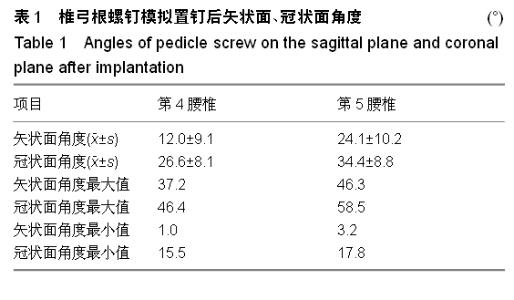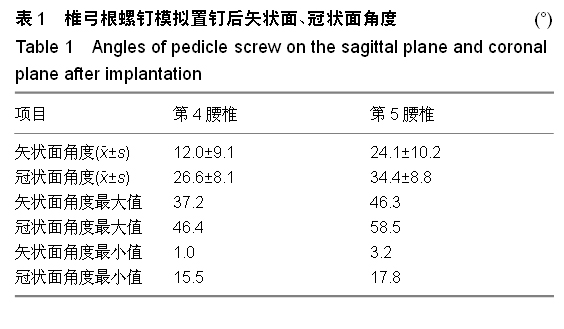| [1] Hicks JM, Singla A, Shen FH, et al. Complications of pedicle screw fixation in scoliosis surgery: a systematic review. Spine. 2010;35(11): E465-470.
[2] Kim YJ, Lenke LG, Bridwell KH, et al. Free hand pedicle screw placement in the thoracic spine: is it safe? Spine. 2004;29: 333-342.
[3] Paik H, Kang DG, Lehman RA Jr, et al. The biomechanical consequences of rod reduction on pedicle screws: should it be avoided? Spine J. 2013;13(11):1617-1626.
[4] 杜心如,赵玲秀,张继宗,等. 腰骶移行椎椎弓根螺钉进钉方法的解剖学研究[J]. 中华骨科杂志,2009,29(1):17-21.
[5] 熊传芝,郝敬明,唐天驷,等. 椎弓根钉道参数的变异性及其相关因素的研究[J]. 中华骨科杂志,2002,22(1):31-35.
[6] Steffee AD, Biscup RS, Sitkowski DJ. Segmental spine plates with pedicle screw fixation. A new internal fixation device for disorders of the lumbar and thoracolumbar spine. Clin Orthop Relat Res. 1986; (203):45-53.
[7] Yilmaz G, Borkhuu B, Dhawale AA. Comparative analysis of hook, hybrid, and pedicle screw instrumentation in the posterior treatment of adolescent idiopathic scoliosis.J Pediatr Orthop. 2012;32(5):490-499.
[8] Rose PS, Lenke LG, Bridwell KH, et al. Pedicle screw instrumentation for adult idiopathic scoliosis: an improvement over hook/hybrid fixation. Spine (Phila Pa 1976). 2009;34(8): 852-857.
[9] Smith ZA, Sugimoto K, Lawton CD, et al. Incidence of lumbar spine pedicle breach following percutaneous screw fixation: a radiographic evaluation of 601 screws in 151 patients. J Spinal Disord Tech. 2012.
[10] Bennett JT, Hoashi JS, Ames RJ. The posterior pedicle screw construct: 5-year results for thoracolumbar and lumbar curves. J Neurosurg Spine. 2013;19(6):658-663.
[11] Khan KM1, Bhatti A, Khan MA. Posterior spinal fixation with pedicle screws and rods system in thoracolumbar spinal fractures. J Coll Physicians Surg Pak. 2012;22(12):778-782.
[12] 曾忠友,金才益,裴婓,等.下腰椎椎弓根螺钉误入椎管损伤神经根的临床分析[J].脊柱外科杂志, 2008, 6(3):178-180.
[13] Hojo Y, Ito M, Suda K. A multicenter study on accuracy and complications of freehand placement of cervical pedicle screws under lateral fluoroscopy in different pathological conditions: CT-based evaluation of more than 1,000 screws. Eur Spine J. 2014;23(10):2166-2174.
[14] Smith ZA, Sugimoto K, Lawton CD, et al. Incidence of lumbar spine pedicle breach after percutaneous screw fixation: a radiographic evaluation of 601 screws in 151 patients.J Spinal Disord Tech. 2014;27(7):358-363.
[15] Tormenti MJ, Maserati MB, Bonfield CM, et al. Complications and radiographic correction in adult scoliosis following combined transpsoas extreme lateral interbody fusion and posterior pedicle screw instrumentation. Neurosurg Focus. 2010; 28(3):1-7.
[16] Samdani AF, Belin EJ, Bennett JT. Unplanned return to the operating room in patients with adolescent idiopathic scoliosis: are we doing better with pedicle screws? Spine (Phila Pa 1976). 2013;38(21):1842-1847.
[17] Kim CW, Lee YP, Taylor W, et al. Use of navigation – assisted fluoroscopy to decrease radiation exposure during minimally invasive spine surgery. Spine. 2008;4: 584-590.
[18] 黄彦,吕浩然,杨进顺,等.术中三维导航引导下脊柱侧凸的椎弓根螺钉置入研究[J].中国矫形外科杂志. 2012, 20(24): 2228-2231.
[19] Yang BP, Wahl MM, Idler CS. Percutaneous lumbar pedicle screw placement aided by computer-assisted fluoroscopy-based navigation: perioperative results of a prospective, comparative, multicenter study. Spine (Phila Pa 1976). 2012; 37(24):2055-2060.
[20] Ovadia D, Korn A, Fishkin M, et al. The contribution of an electronic conductivity device to the safety of pedicle screw insertion in scoliosis surgery. Spine. 2011;20: 1314-1321.
[21] Ringel F, Stüer C, Reinke A. Accuracy of robot-assisted placement of lumbar and sacral pedicle screws: a prospective randomized comparison to conventional freehand screw implantation. Spine (Phila Pa 1976). 2012;37(8):E496-501.
[22] Patil S, Lindley EM, Burger EL. Pedicle screw placement with O-arm and stealth navigation.Orthopedics. 2012;35(1): e61-65.
[23] Villard J, Ryang YM, Demetriades AK. Radiation exposure to the surgeon and the patient during posterior lumbar spinal instrumentation: a prospective randomized comparison of navigated versus non-navigated freehand techniques. Spine (Phila Pa 1976). 2014;39(13):1004-1009.
[24] Van de Kelft E, Costa F, Van der Planken D, et al. A prospective multicenter registry on the accuracy of pedicle screw placement in the thoracic, lumbar, and sacral levels with the use of the O-arm imaging system and StealthStation Navigation.Spine (Phila Pa 1976).2012;37(25):E1580-1587.
[25] 杨波,方世兵,尹飚,等.三维重建腰椎椎弓根螺钉置入的精确性[J]. 中国组织工程研究,2013,17(13):2333-2338.
[26] 马岩, 李岩,马威,等.中国北方地区成人椎弓根形态的测量及其临床意义[J].中国临床解剖学杂志, 2009,27(3): 295-298.
[27] 杜良杰,李建军.国人成年男性胸腰椎椎弓根径线和偏角与脊椎节段序数的相关性研究[J].中国脊柱脊髓杂志. 2009, 19(7): 545-549.
[28] 庞小平,于海龙,李小龙,等.以CT三维重建技术测量颈椎椎弓根螺钉的置入参数[J]. 中国组织工程研究与临床康复,2010,14(9): 1555-1558.
[29] 方世兵,杨波,李长树,等.数字腰椎在椎弓根螺钉置入中的应用研究[J].中国数字医学,2013,8(1):13-15.
[30] 于海龙,项良碧,刘军,等. CT三维重建技术在手术治疗胸腰段椎体骨折中应用[J].中国矫形外科杂志,2010,18(2):157-159.
[31] Cui G, Watanabe K, Hosogane N, et al. Morphologic evaluation of the thoracic vertebrae for safe free-hand pedicle screw placement in adolescent idiopathic scoliosis: a CT-based anatomical study. Urg Radiol Anat. 2012;34(3):209-216.
[32] 陈玉兵,陆声,徐永清,等.个体化导航模板辅助腰椎椎弓根螺钉置钉准确性实验研究[J].中国脊柱脊髓杂志,2009,19(8)l623-626.
[33] Zhao L, Li G, Liu J. Radiological studies on the best entry point and trajectory of anterior cervical pedicle screw in the lower cervical spine. Eur Spine J. 2014;23(10):2175-2181.
[34] Kotani T, Naqaya S, Sonoda M, et al. Virtual endoscopic imaging of the spine. Spine (Phila Pa 1976). 2012;37(12): E752-756.
[35] 王建华,夏虹,吴增晖,等.数字骨科技术在儿童上颈椎手术中的应用[J]. 中国脊柱脊髓杂志, 2012, 22(6):516-520.
[36] 林山,尹庆水,夏虹,等.数字化重建与快速成型技术在复杂上颈椎疾患诊治中的应用[J].中国脊柱脊髓杂志,2011,21(1):16-20.
[37] 谭培勇,项舟,宋彬,等.数字仿真技术确定最佳骶髂螺钉通道的研究[J]. 中国脊柱脊髓杂志, 2012, 22(7):634-640.
[38] 曹珺,何飞,余伟巍,等.脊柱虚拟手术系统的构建及功能实现[J].中国脊柱脊髓杂志, 2011, 21(5):408-411.
[39] Gasco J, Patel A, Ortega-Barnett J. Virtual reality spine surgery simulation: an empirical study of its usefulness. Neurol Res. 2014;36(11):968-973.
[40] Yang M, Li C, Li Y, et al. Application of 3D rapid prototyping technology in posterior corrective surgery for Lenke 1 adolescent idiopathic scoliosis patients. Medicine (Baltimore). 2015; 94(8):e58. |

